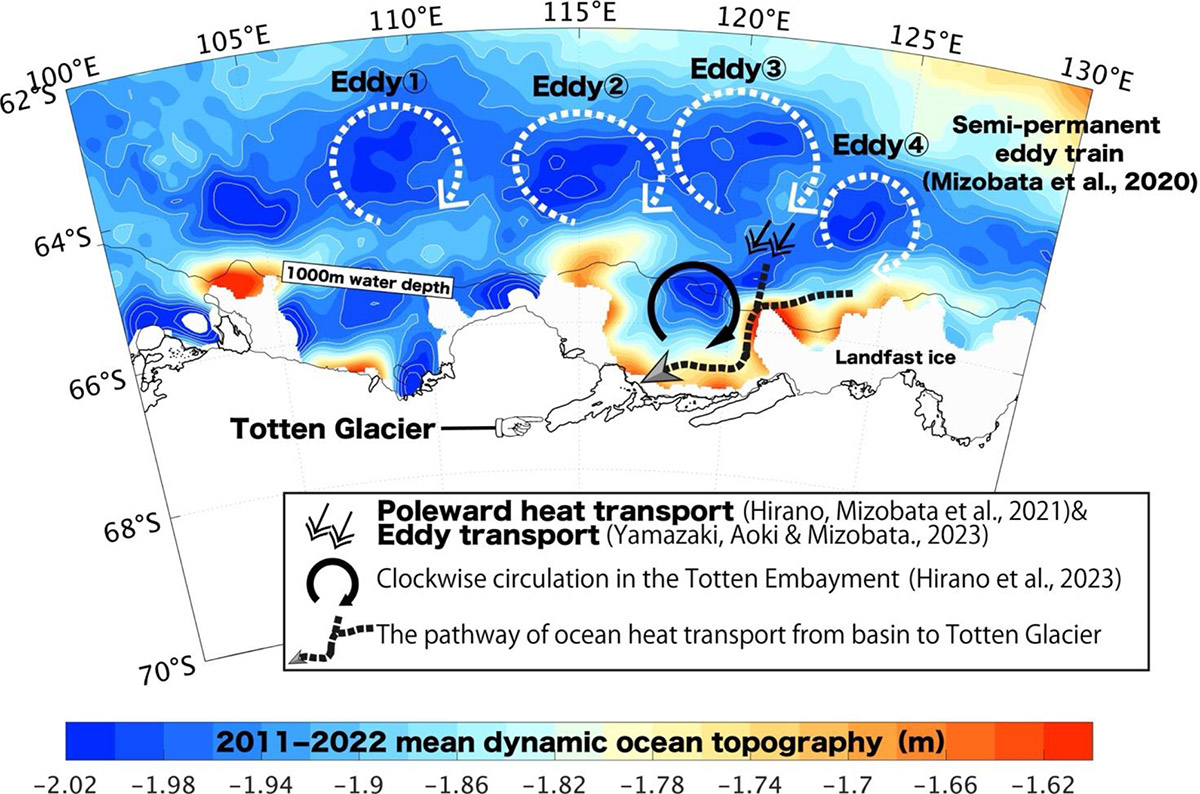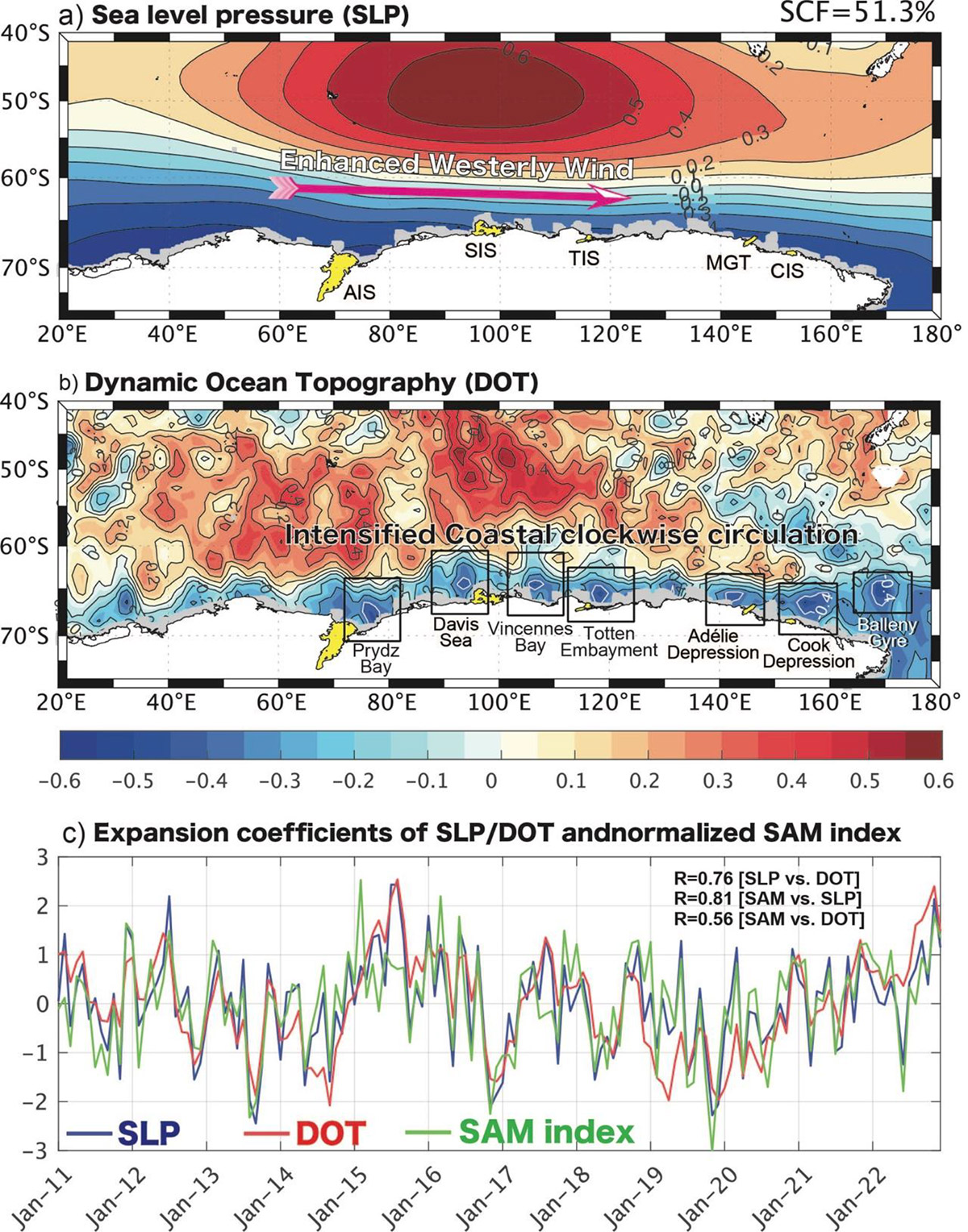National Institute of Polar Research
Enhanced westerly winds lead to increased ocean heat transport to the East Antarctic Ice Sheet
~Mechanism of Global Warming Accelerating Antarctic Ice Sheet Melting~
April 3, 2025
Tokyo University of Marine Science and Technology
National Institute of Polar Research
Japan Agency for Marine-Earth Science and Technology (JAMSTEC)
Hokkaido University
Key points
- In the coastal areas of East Antarctica, which is a covered by a huge ice sheet, the melting of the ice sheet by warm seawater has been revealed. However, to predict the future ice sheet melting with high accuracy, it was necessary to clarify the ocean circulation that transports warm seawater and the factors that cause its variability.
- Through analysis using originally developed satellite-derived dynamic ocean topography data*1 and sea level pressure data, we have elucidated that (1) clockwise ocean circulation carrying warm water is scattered in the coastal areas of East Antarctica, and (2) these ocean circulations are enhanced by the strengthening of westerly winds.
- The results of this study suggest that global warming is expected to accelerate ice sheet loss in the East Antarctic coastal region via changes in the ocean. The results of this study will contribute not only to a comprehensive understanding of East Antarctic ice sheet changes, but also to improving the accuracy of sea-level rise predictions.
A research group led by Associate Professor Kohei Mizobata, Tokyo University of Marine Science and Technology (President: Toshio Iseki, hereafter “TUMSAT”); the National Institute of Polar Research; the Japan Agency for Marine-Earth Science and Technology; and the Institute of Low Temperature Science, Hokkaido University, has found that enhanced westerly winds associated with global warming will strengthen the clockwise circulations and heat transport to the ice sheet in the East Antarctic coastal area.
Loss of the Antarctic ice sheet has traditionally been cited as one of the main causes of global mean sea-level rise. Melting due to the inflow of warm seawater from the open ocean has been especially highlighted as a factor contributing to the loss of the Antarctic ice sheet. On the other hand, an understanding of the response of the Antarctic ice sheet to ongoing global warming has been desired.
Using originally developed satellite-derived dynamic ocean topography data and atmospheric reanalysis data, this research group not only clarified that clockwise circulations transporting warm seawater to the Antarctic ice sheet are scattered in the East Antarctic coastal region but also revealed that the strengthening of westerly winds enhances these oceanic circulations and associated heat transport through statistical analysis.
Based on the results of this study, enhanced ocean circulation and heat transport in the East Antarctic coastal region and accelerated ice sheet melting are expected to occur due to global warming. The findings of this study are also expected to help improve the accuracy of future projections of sea level rise.
The results of this research were published online in Geophysical Research Letters on March 15, 2025 at 5:14 p.m. (JST).
https://agupubs.onlinelibrary.wiley.com/doi/10.1029/2024GL112914
Background
About 90% of the ice on Earth is located in Antarctica; if all this ice were to melt, the global sea level would rise by more than 50 meters. In addition, the ice sheets in West Antarctica and East Antarctica could be eroded by seawater to the equivalent of 3.4 m and 19.2 m of global sea level rise, respectively. Melting of the Antarctic ice sheet has been reported mainly in West Antarctica, but recently warm seawater melting in Totten Glacier, one of the largest glaciers in East Antarctica, has begun to be noted (Rintoul et al., 2016).
Future projections based on global warming scenarios indicate that sea level will rise by 0.82 m by the end of the 21st century compared to the end of the 20th century, with a rise in sea level of 0.03 to 0.34 m due to the melting of the Antarctic ice sheet. The main reason for the uncertainty in this future projection is that there are many unknowns regarding the “response of the Antarctic ice sheet to global warming.”
The research group has intensively conducted in situ observations in the Totten embayment, with a particular focus on the transport pathways of warm seawater that cause the melting of the Antarctic ice sheet. As a result, it has become clear that warm seawater transported southward (toward Antarctica) by semi-permanent oceanic eddies*2 in the distant open ocean basin is further transported below Totten Glacier by clockwise circulation in the Totten embayment (Fig. 1) (e.g., Hirano et al., 2023). However, the “time-varying mechanism of ocean circulation,” which is the cause of variation in the amount of ice sheet melting, is still unknown, and its elucidation has been an urgent issue.
Given this circumstance, we have integrated satellite observation data, atmospheric reanalysis data, and in situ observation data under the Phase X Priority Research and Observation Project of the Antarctic Regional Observation, and attempted to clarify ocean circulation and its variability in the entire coastal region of East Antarctica, where not only Totten Glacier but also enormous ice sheets exist.
Results
One of the most important pieces of information for understanding ocean circulation is the spatial distribution of sea-surface height as determined by Earth observing satellites. Normally, sea ice in the Antarctic and Arctic Oceans is an obstacle to the estimation of sea-surface height. We developed a method to obtain sea-surface height information even in sea-ice areas, by extracting only the signal from the sea surface and eliminating the signal from sea ice based on the pulse waveform of the satellite radar altimeter data. Next, by synthesizing sea-surface height information in sea ice-free waters, a new dynamic ocean topography data set was constructed for the period from January 2011 to December 2022.
The dynamic ocean topography data revealed the existence of a clockwise circulation not only in the waters around Totten Glacier, but also in Prydz Bay and Vincennes Bay, and that the sea surface dynamic height fluctuates in tandem despite the spatial distance between the two areas. These results suggest that changes in the atmospheric field dominate changes in the oceans. Furthermore, we have performed a singular value decomposition analysis on the dynamic ocean topography data and the sea level pressure data provided by the European Centre for Medium-Range Weather Forecasts. This statistical analysis allows us to extract the spatio-temporal structure of the high correlation between the two physical quantities (in this case, dynamic ocean topography and sea level pressure). The results show that enhanced westerly winds in East Antarctica strengthen the clockwise circulation not only in the bays mentioned above, but also in many East ntarctic coastal areas such as Davis Sea and the Adélie Depression (Fig 2).
Variations in westerly wind intensity alter not only the clockwise circulation but also the amount of ocean heat transport to the East Antarctic Ice Sheet. The strength of the westerly wind is expressed by the Southern Annular Mode Index (SAM index; Marshall, 2003). The average ocean heat transport in the Totten Embayment was calculated for negative and positive SAM index period, and the difference was found to be 0.1 tera Watts (10 gigatons of ice sheet melt, or about 17% of the average melt).
Future Perspective
Future projections based on global warming scenarios indicate that westerly winds will strengthen until the latter half of the 21st century. The results of this study point to enhanced ice sheet melting in the East Antarctic coastal region via enhanced ocean circulation under global warming. The findings of this study will contribute not only to a comprehensive understanding of East Antarctic ice sheet fluctuations, but also to improving the accuracy of sea level rise predictions.
Figures

Figure 1: Ocean heat transport pathways to Totten Glacier revealed so far by this research group. Background color is the mean dynamic ocean topography for the period 2011-2022. A deep ocean basin is extending north of the 1000 m depth contour line. In-situ observations have confirmed the existence of stationary oceanic eddy trains (eddies ① to ④) in the basin area and the existence of clockwise circulation on the continental shelf.

Figure 2: The most highly correlated a) sea level pressure distribution and b) sea level height distribution obtained from the singular value decomposition analysis. c) Time functions of a) and b) are shown by blue and red lines, respectively. The green line shows the normalized SAM index, and the correlation coefficients between the temporal variation of a) and b) and the SAM index are shown in the upper right of the figure.
Glossary
*1 Dynamic Ocean Topography
The distance from the reference ellipsoid to the sea surface is called the sea-surface height. The geoid height, which is consistent with the earth's mean sea level, is subtracted from the sea-surface height to obtain the dynamic ocean topography. The dynamic ocean topography is an important piece of information in understanding ocean currents.
*2 Semi-permanent oceanic eddies
Four clockwise eddies, each about 150-200 km in diameter, exist in roughly the same location in the ocean basin region, and the eastern part of each ocean eddy transports warm ocean water to the south (Mizobata et al., 2020; Hirano et al., 2021).
References
Hirano, D., Mizobata, K., Sasaki, H. et al. Poleward eddy-induced warm water transport across a shelf break off Totten Ice Shelf, East Antarctica. Commun Earth Environ 2, 153 (2021). doi:10.1038/s43247-021-00217-4
Hirano, D., Tamura, T., Kusahara, K., Fujii, M., Yamazaki, K., Nakayama, Y. et al. (2023). On-shelf circulation of warm water toward the Totten Ice Shelf in East Antarctica. Nature Communications, 14 (1), 4955. doi:10.1038/s41467-023-39764-z
Marshall G. J. (2003). Trends in the Southern Annular Mode from observations and reanalyses. Journal of Climate, 16, 4134–4143. doi: 10.1175/1520-0442(2003)016<4134:TITSAM>2.0.CO;2.
Mizobata, K., Shimada, K., Aoki, S., Kitade, Y. (2020). The cyclonic eddy train in the Indian Ocean sector of the Southern Ocean as revealed by satellite radar altimeters and in situ measurements. Journal of Geophysical Research: Oceans, 125, e2019JC015994. doi:10.1029/2019JC015994
Rintoul, S. R., Silvano, A., Pena-Molino, B., van Wijk, E., Rosenberg, M., Greenbaum, J. S., & Blankenship, D. D. (2016). Ocean heat drives rapid basal melt of the totten ice shelf. Science Advances, 2 (12), e1601610. doi:10.1126/sciadv.1601610
About this article
Journal:Geophysical Research Letters
Title:“Ocean Response Along the East Antarctic Coastal Margin to the Southern Annular Mode”
Authors:
Kohei Mizobata(Department of Ocean Sciences, Tokyo University of Marine Science and Technology)
Daisuke Hirano(National Institute of Polar Research)
Kazuya Kusahara(Japan agency for Marine-Earth Science and Technology)
Shigeru Aoki(The institute of Low Temperature Science, Hokkaido University)
Jun Inoue(National Institute of Polar Research)
Shintaro Takao(National Institute for Environmental Science)
Ryosuke Makabe(National Institute of Polar Research)
DOI:10.1029/2024GL112914
Acknowledgement
This work was supported by Grants-in-Aids for Scientific Research (JP18H05051, JP20H04970, JP21H03587, JP21H04931, JP24H02340, JP24H02341) from the Ministry of Education, Culture, Sports, Science and Technology, Science Program of the Japanese Antarctic Research Expedition (JARE) as a Prioritized Research Project, National Institute of Polar Research (NIPR) through Project Research KP-303, Center for the Promotion of Integrated Sciences of SOKENDAI, and the Grant for Joint Research Program of the Institute of Low Temperature Science, Hokkaido University. (22S012, 23S017, and 24S015).
Contact
Contact regarding research
Tokyo University of Marine Science and Technology
Department of Ocean Sciences
Associate Professor Kohei Mizobata
Email: mizobata@kaiyodai.ac.jp
Contact for interviews
Tokyo University of Marine Science and Technology
Public Relations Office
E-mail: so-koho@o.kaiyodai.ac.jp
Inter-university Research Institute Corporation Research Organization of Information and Systems National Institute of Polar Research
Public Relations Office
E-mail:koho@nipr.ac.jp
Japan Agency for Marine-Earth Science and Technology (JAMSTEC)
Press Office
E-mail: press@jamstec.go.jp
Hokkaido University
Public Relations & Communications Division, Office of Public Relations and Social Collaboration
Email: en-press@general.hokudai.ac.jp








